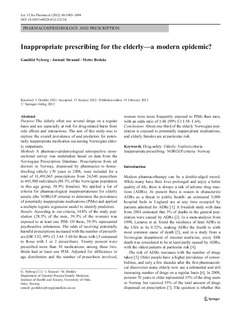| dc.contributor.author | Nyborg, Gunhild | |
| dc.contributor.author | Straand, Jørund | |
| dc.contributor.author | Brekke, Mette | |
| dc.date.accessioned | 2017-06-07T12:41:11Z | |
| dc.date.available | 2017-06-07T12:41:11Z | |
| dc.date.issued | 2012 | |
| dc.identifier.citation | Nyborg, G., Straand, J. & Brekke, M. (2012) Inappropriate prescribing for the elderly—a modern epidemic? European Journal of Clinical Pharmacology, 68(7), s. 1085–1094. | |
| dc.identifier.uri | http://hdl.handle.net/11250/2445210 | |
| dc.description | Tverrsnittstudie hvor hensikten var å undersøke forekomst av uheldige forskrivninger til eldre som bor hjemme. | |
| dc.description.abstract | PURPOSE: The elderly often use several drugs on a regular basis and are especially at risk for drug-related harm from side effects and interactions. The aim of this study was to explore the overall prevalence of and predictors for potentially inappropriate medication use among Norwegian elderly outpatients.
METHODS: A pharmaco-epidemiological retrospective cross-sectional survey was undertaken based on data from the Norwegian Prescription Database. Prescriptions from all doctors in Norway, dispensed by pharmacies to home-dwelling elderly ≥ 70 years in 2008, were included for a total of 11,491,065 prescriptions from 24,540 prescribers to 445,900 individuals (88.3% of the Norwegian population in this age group, 58.9% females). We applied a list of criteria for pharmacological inappropriateness for elderly people (the NORGEP criteria) to determine the prevalence of potentially inappropriate medications (PIMs) and applied a multiple logistic regression model to identify predictors.
RESULTS: According to our criteria, 34.8% of the study population (28.5% of the men, 39.3% of the women) was exposed to at least one PIM. Of these, 59.9% represented psychoactive substances. The odds of receiving potentially harmful prescriptions increased with the number of prescribers (OR 3.52, 99% CI 3.44-3.60 for those with ≥ 5 compared to those with 1 or 2 prescribers). Twenty percent were prescribed more than 10 medications; among these two-thirds had at least one PIM. Adjusted for differences in age distribution and the number of prescribers involved, women were more frequently exposed to PIMs than men, with an odds ratio of 1.60 (99% CI 1.58-1.64).
CONCLUSIONS: About one-third of the elderly Norwegian population is exposed to potentially inappropriate medications, and elderly females are at particular risk. | |
| dc.language.iso | eng | |
| dc.subject | pasientsikkerhet | |
| dc.subject | legemiddel | |
| dc.subject | legemiddelbruk | |
| dc.subject | legemiddelinteraksjoner | |
| dc.subject | legemiddelforskrivning | |
| dc.subject | uhensiktsmessig legemiddelbruk | |
| dc.subject | legemiddelrelaterte problemer | |
| dc.subject | allmennmedisin | |
| dc.subject | allmennpraksis | |
| dc.subject | register | |
| dc.subject | reseptregister | |
| dc.subject | farmakoepidemiologi | |
| dc.subject | NORGEP | |
| dc.subject | kriterier | |
| dc.subject | tverrsnittstudie | |
| dc.subject | hjemmeboende | |
| dc.subject | eldre | |
| dc.subject | Norge | |
| dc.title | Inappropriate prescribing for the elderly—a modern epidemic? | |
| dc.type | Journal article | |
| dc.rights.holder | Nyborg, Gunhild | |
| dc.source.volume | 68 | |
| dc.source.journal | European Journal of Clinical Pharmacology | |
| dc.source.issue | 7 | |
| dc.identifier.doi | 10.1007/s00228-012-1223-8 | |
